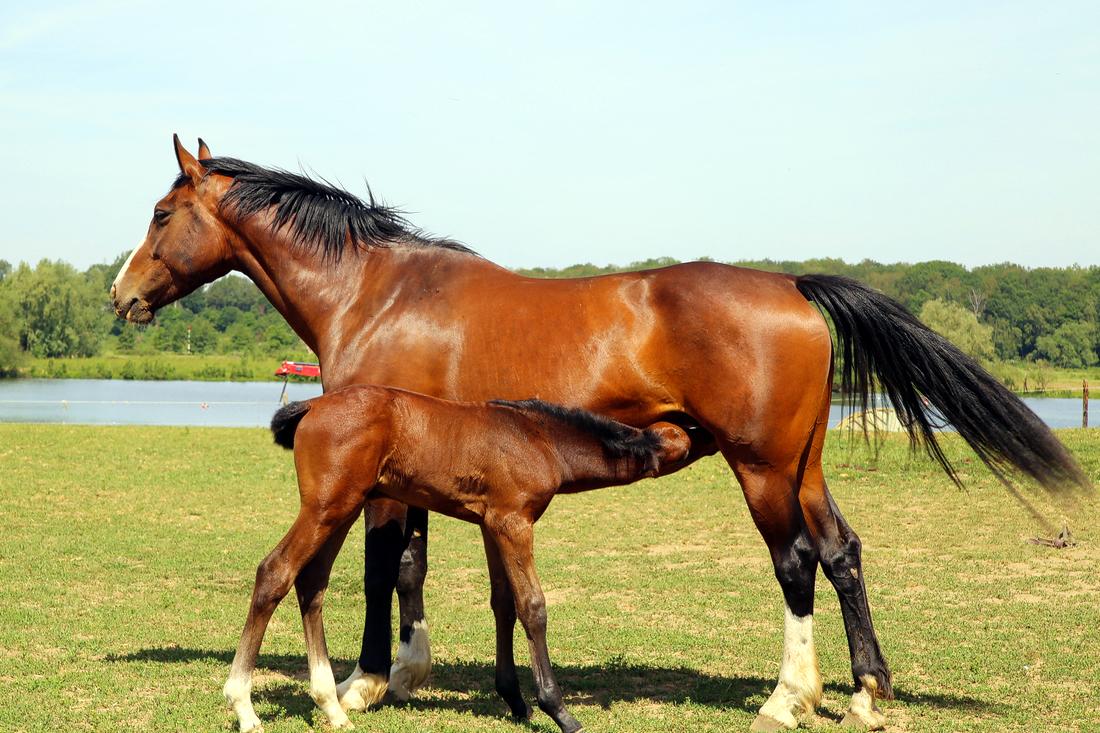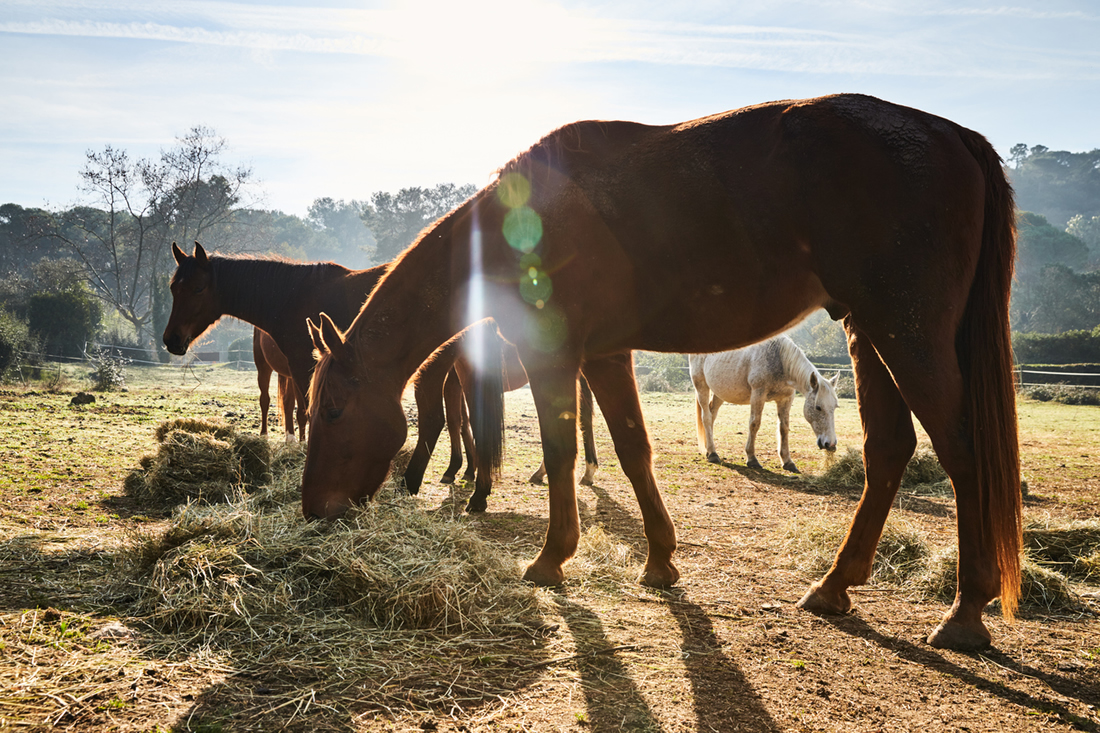Are you considering setting up a track system such as the Paddock Paradise for your horse?
In recent decades, many horse owners have shown interest in natural equine management and care practices. These practices seek to mimic the lifestyle of wild horses.
Whether by feeding a forage-based diet, providing more turnout time with other horses, or opting for barefoot hoof care, several management strategies promote natural behaviour in domesticated horses.
However, it is difficult for domestic horses to match the amount of movement that wild horses experience daily. Feral horses can cover up to 18 miles (30 km) in a single day. [3]
As most of us cannot ride our horses for several hours each day, how does one encourage their horse to move more on their own? The solution is track system built around existing pastures or property, also referred to as a Paddock Paradise.
Jaime Jackson, a barefoot hoof care practitioner, developed the Paddock Paradise after studying wild horse behaviour. This concept is designed to mimic the movement of wild horse herds and encourage natural behaviours in domestic horses. [1]
Paddock Paradise for Horses
Jaime Jackson designed the Paddock Paradise concept based on the lifestyle of the wild and free-roaming American Mustangs living in the U.S. Great Basin.
A Paddock Paradise system gives domestic horses an environment resembling their natural habitat. [1]
Horses in the wild move from food to water to shelter and then back again, creating tracks over their range area. They also move as a herd, both for safety and because the horse is a social animal.
Under modern management practices, horses are often kept in stalls with limited turnout or are maintained on small paddocks where they stand in one area to graze for long periods.
A Paddock Paradise allows domestic horses to live together on a track system and encourages movement to find food, water, and shelter.

Key Features
A Paddock Paradise track system can be used on different terrains and different-sized properties.
The design can be as simple as running an electric fence parallel to the perimeter fence of a rectangular pasture, or it can be made more complex. The center pasture remains protected and can be used for grazing other livestock or baling hay.
The main goal of a Paddock Paradise is to promote equine welfare and maintain sound and healthy horses.
Movement can help prevent many illnesses and disorders that affect our domestic horses living in stalls or close confinement. Track systems also avoid the dangers of grazing on lush pastures, which can be hazardous to horses with metabolic issues. [1]
A Paddock Paradise also provides a more stimulating environment for horses which discourages stereotypic behaviour such as cribbing or wood chewing. [2]
Mimicking Wild Horse Movement
The Paddock Paradise design promotes behaviours that are similar to those seen in wild horses.
In the wild, horses move along familiar routes or tracks and instinctively walk in single-file formation as they travel vast distances in search of food, water and shelter. [1]
One study following 12 feral horses living in Australia found that they travelled on average 5.9 kilometres (9.9 miles) per day.
At times, these horses were recorded 55 kilometres (34 miles) away from their watering points. Some horses walked for 12 hours to find source of water. [3]
Another study found that horse herds are often triggered to move because of the actions of a single horse, who is usually the dominant horse in the group. [4]
Horses are prey animals and rarely linger in one area for too long. Instead, to evade predators they tend to stay on the move, only stopping to graze or browse for short periods. [1]
A track system encourages similar movement patterns, and helps keep your horse active and moving throughout the day.

Addressing Obesity in Horses
Obesity in domestic horses is reported to be as high as 50% in some populations . [10]
Horses that are obese have a higher risk of health conditions such as equine metabolic syndrome (EMS), reproductive problems, and osteochondrosis. [5]
Modern management practices can contribute to obesity by promoting a sedentary lifestyle and feeding diets high in energy. Some factors that increase the risk of obesity include:
- Lush pastures
- Energy-dense complete horse feeds
- Small property sizes that limit exercise
Researchers also believe that a sedentary lifestyle from an early age can adversely affect a horse’s musculoskeletal health. [3]
Paddock Paradise for Weight Loss
Unlike traditional pastures and boarding situations, a Paddock Paradise encourages movement, which can help horses lose weight and improve their body condition.
Track systems may also help prevent conditions related to overgrazing such as founder and colic.
In one study, researchers used a new feeding system which required ponies to move more to access hay. The custom-made feeder was only accessible from one side at a time, with two sliding doors that opened alternately on each side of the feeder for a predetermined amount of time. [5]
A dividing fence was used in the center of a narrow, rectangular pen to increase the distance walked by the ponies as they moved to gain access to the other side of the feeder. [5] This created a track system similar to a Paddock Paradise.
The researchers found that the ponies moved over 3.5 times more than with a traditional hay feeder. Over a three-month period, this consistent exercise decreased body fat by 5% and improved the body condition of the ponies. [5]
Exercise can also improve insulin signalling in the horse’s skeletal muscles post-exercise, contributing to improved metabolic health. [9]
Supporting Equine Behaviours with a Track System
The goal of a Paddock Paradise is not only to increase movement but also to support species-appropriate behaviours that are naturally expressed by wild horses.
The following natural behaviours can be encouraged through the design of a track system:
1) Diet and Feeding Behaviour
One of the most important elements of designing a Paddock Paradise is ensuring appropriate forage and feed availability.
Wild horses spend 10-17 hours a day grazing or browsing for roughage. Their digestive system is designed to continuously take in small amounts of food throughout the day.
Ensure that enough forage is provided along the track to meet natural feeding behaviour and energy requirements, while also promoting movement. [1] If grass is unavailable, spread hay around the track at regular intervals.
Slow hay feeders are a good option for a Paddock Paradise. Feeders come in many different forms and can be strategically placed around the track to slow down hay consumption and keep your horse busy for a longer period of time.
Placing slow feeders at ground level or as close to ground level as possible will help support a natural grazing position.
Since wild horses consume a wide variety of vegetation, you can also plant horse-appropriate shrubs and herbs along the edges of your track for your horses to browse. [1]
Also, make sure to provide free-choice loose salt around the track and feed a daily vitamin and mineral supplement to prevent nutrient deficiencies in your horse’s diet.
2) Watering Behaviour
All horses need access to fresh clean water. A typical adult horse requires 25 litres (6.6 US gallons) of water per day, and this requirement increases in hot weather or when exercising.
Provide watering stations at different spots around your Paddock Paradise to ensure adequate hydration. The need to seek out water also encourages your horse to move around the track.
3) Manure Piles
One drawback of the Paddock Paradise track system is that manure will pile up along the track. Manure accumulation needs to be managed to reduce the risk of parasites and to control flies.
However, you can deliberately leave some manure to enable natural expressions of dominance and coprophagous (dung-eating) behaviour – which is common in young horses. [1][6]
Stud piles are a way for horses to mark territory and establish dominance in a social hierarchy. Even if you don’t have a stud or gelding, leaving a small pile of manure is not harmful and may stimulate movement. [6]
4) Rolling and Bathing Behaviour
Rolling and bathing are two other natural behaviours that help horses find relief from insects and heat. Wild horses take mud baths in their watering holes and enjoy dust baths.
If you can provide an area for one or both of these activities along your track, you can help to support natural horse behaviour. [1]
5) Camping Behaviour
Although most of a horse’s time is occupied by eating, roughly a third of a horse’s life consists of what Jaime Jackson calls “camping behaviours” [1][11], which include
- Resting
- Mutual or self-grooming
- Sleeping
Horses in a Paddock Paradise need locations to engage in these behaviours. Provide several larger areas along your track where horses can comfortably lie down to sleep or rest. [1]
6) Play Behaviour
Jaime Jackson also recommends that horses be removed from the track and placed in a large pen or in the center part of the track for an hour at least once a day to engage in play behaviour.
Play behaviour may resemble running, kicking, play-fighting, or chasing. If possible, let all the horses into this pen simultaneously to encourage this type of play. [6]
Implementing a Track System
Paddock Paradise track systems can be built in any shape and on nearly any type of terrain.
The easiest way to create a Paddock Paradise is by placing an electric fence approximately 10-15 feet away from your perimeter fence to create a track. You can also install a more permanent fence if desired.
The following tips can help you create a safe and stimulating Paddock Paradise for your horses [2][6][7]:
- Keep the number of horses in mind when deciding the width of your track. Narrow tracks encourage more movement. However, if the track is too narrow less dominant horses may get cornered by a more dominant horse.
- Add different textures for your horses to walk over in the track. This could include pea gravel, rocks, sand, or packed dirt. This can help keep barefoot hooves in good condition.
- Plant a variety of horse-friendly plants along the edge of your track for your horses to browse.
- If grass is abundant on your track and is limiting movement or causing health problems, consider adding other livestock such as cattle, sheep, llamas, or goats. These animals can be kept temporarily until the grass is grazed down.
- Grass can also be tilled under or scraped up with a box blade.
- Ensure that some form of shelter is connected to the track. This could be a shed, barn, or grove of trees.
For more information on building a Paddock Paradise, you can read Jaime Jackson’s book: Paddock Paradise: A Guide to Natural Horse Boarding.
References
- Jackson, Jaime. What is Paddock Paradise?
- Edwards, Jenny. Paddock Paradise. All-Natural-Horse-Care.
- Hampson, B.A., et al. Distances travelled by feral horses in ‘outback’ Australia. Equine Vet Journal. 2010.
- Krueger, K. et al. Movement initiation in groups of feral horses. Behavioural Processes. 2013.
- de Laat, M.A. et al. Sustained, Low-Intensity Exercise Achieved by a Dynamic Feeding System Decreases Body Fat in Ponies. J Vet Intern Med. 2016.
- Jackson, Jaime, Paddock Paradise: A Guide to Natural Horse Boarding. Star Ridge Publishing. 2013.
- Cook, J. Paddock Paradise Track System for Horses. Colorado State Extension.
- Welcome to Paddock Paradise. AANHCP.
- McCutcheon, L.J. et al. Effects of prior exercise on components of insulin signalling in equine skeletal muscle. Equine Vet Journal. 2010.
- Rendle, D. et al. Equine obesity: current perspectives. UK-Vet Equine. 2018.
- Boyd, L.E. et al. The 24-hour time budget of Przewalski horses. Applied Animal Behaviour Science. 1988.











Leave A Comment